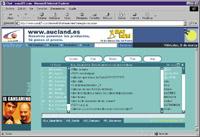Dependence of the Internet

IAD (Internet Addiction Disorder) or imbalance of dependence on the Internet. With this name is known the pathological entity that describes Kimberly Young, a prestigious psychologist at the University of Pittsburgh. For some authors, IAD is an evil, while for others it does not reach that level. However, there are studies that indicate that there are people who forget their usual tasks and spend hours and hours connected to the Internet. In Spain there are already two and a half million people who connect to the network (7.1% of the population). Of these, 21% goes to these chats with tasks of giant meeting rooms. In 14% of the cases studied among US university students, symptoms of "bad" IAD are observed. According to Dr. Young, 400,000 Americans generally rely on "internality." As a result, more and more articles are being published to inform society of this risk or to help people who already depend on the network. Listening to talk about this topic in magazines and medical congresses also talks about the seriousness of the problem.
Today we have before us new ways of communication, a reality much more complex than radio, cinema or television. Our family member Martin can be a friend of Tomy from the United States. They may have never been seen, but they may be in contact every day. However, this leads Martin and Tomy to be many hours each day in front of their computers, with more chances of falling into dependence on the Internet. Martin and Tomy's parents will not realize anything until they reach worrying levels of IAD. Probably the excessive increase of the telephone bill is the first signal that turns on the red light, or it may happen that Tomy or Martin recognize that in many years have spent a good part of their life connected to the Internet. Meanwhile, the "disease" has been hidden for others.
But before we get to this situation, how can we know whether there is dependence or not? Kimberly Young talks about certain symptoms: in order to be connected more and more time the daily habits are changed, the sleep is less hours, the friendly relationships are reduced, the personal tasks are forgotten, the anger is not to be connected, it is constantly checked if there are messages in the email and the internet connection provokes a special cry in the person. Professor Enrike Etxeburua indicates when the dependency begins, that is, "when that need to be connected enters the daily life of each person or it is sought not to have a bad time instead of looking for fun."
The situation is really worrying: In a study by Firefly around the world, 50% of respondents claimed to have a clear need for information. However, the user parents showed a more raw reality. 50% of them argued that their children prefer PCs to friends. "You earn virtual friends, but those of reality are lost, those who are really important," say the webaholic, that is, those who supposedly have IAD.
.Looking for reasons
Experts have begun to analyze the reasons why these behaviors have been avoided. For this purpose, they have analyzed the characteristics of computers and the Internet and the following conclusions have been drawn from this study:
- The Internet offers a great opportunity for entertainment, both strictly speaking, and for its satisfaction with the curiosity of users.
- Users communicate better through the Internet than in person. In addition, the Internet offers the possibility of becoming a character created to your liking. That is, everyone becomes the idol of himself.
- Some authors highlight the technical characteristics of computers and the internet:
- a) Interaction: Computers offer us the possibility to interview a person in an almost natural way. b) Demassification: Internet messages can be both private (for a given recipient) and public (for a large group of recipients), depending on the expectations of each one. c) Asynchronism: Messages can be received at the time the user wishes and at any time. However, with the rest of the media, the same does not happen. For example, it is not the same to receive the message by phone as by answering machine.

All these features can induce anyone to be trapped by the fascination of the network. However, some authors point out the characteristics of the subjects most likely to this dependence. For the Canadian Michael O´Reilly, the biggest risk of falling into addiction is people who work at home, especially middle-aged women, those who have a low educational level and students of any age and socioeconomic level. For his part, Professor Alonso Fernández describes the person dependent on the Internet as: "man, young, student or professional who uses the network to work, with an inclusive nature and who has been able to suffer failures in school."
Psychologists put their eyes above all on those who are timid. In this sense, Anoria, who likes chat, says: "People tell on the net things they wouldn't dare say face to face, because it's a way to reduce their loneliness or frustation."
Consequently, the causes of dependence can be multiple: loneliness, insecurity, labor problems, depression, hastiness…
John Suler and other authors make a more scientific distribution of those affected by IAD. Within this hypothetical dependence, according to Suler, two types of subjects can be distinguished:
a) Those who use the network to collect information, play, obtain new programs or similar tasks (without relation to other users).
b) Email lists with mute favorites (Multi User Dimension) or chats that are frequently visited.
The goal of the second group is to achieve human esteem. Those of the first group need control and avoid human relations.

There are authors who equate IAD with alcoholism, ludopathy and drug dependence. Others, such as psychologist Juan Alberto Estallo Marti, are much more prudent and do not dare to talk about the "imbalance of dependence". According to Estallo, studies indicate that there are people who have suffered significant changes in their lives as a result of the use of the network. However, from there to talk about "imbalance of dependence" there is a lot of way.
MUD and chat: technological opportunities to talk with others
The MUSMs are worlds created by imagination, role-playing games. In the MUD we must first create our own identity, that is, a pseudonym for the other participants to know us. Below are the characteristics of the character we have created. This creates a scenario with different identities and roles.
MUDs are very attractive places, but at the same time the huge hours spent by MUDs in front of the computer make them fearsome. The University of Amherst, in Australia, in 1992 banned MUQs claiming they generated dependence among university students.
IRC or Internet Relay Chat is a protocol that allows you to exchange messages between users. To be able to connect to the IRC it is necessary to have a program that serves for it. Each IRC includes four types of discussion channels: public channels, secret channels, hidden channels and compressed channels.
Once connected to the IRC, if you want to protect your own identity, you must select an alias (nickname). From that moment on, what one writes through the keyboard is seen by the rest of the channel participants, but even with one or more specific participants, they can be private interviews.
Many experts in the subject consider chat as the most important cause of dependence on the Internet. In this sense, the user of the IRC Nico indicates: "Entering the chat is like going to the psychologist, a very special communication is created".
Doctor, I need help
Prevention is the most effective way to deal with dependence on the Internet. Experts say that it is necessary to inform previously the professionals of education and health and society in general. Other tips are the reduction of the connection time, the proper organization of the tasks to be carried out on the network, and the inclusion on the Internet of messages that inform about the damage that can cause the excessive use of this media. As for children, experts mention the following preventive measures: organize their free time and encourage them to participate in sports or similar social activities.
However, after falling into the clutches of the network, everyone is the one who has to try to get out of the dependency, accepting the situation and taking advantage of the time he used to surf the Internet for other tasks. It is very important that each one reduce their connection times and for this we must be really motivated. In this sense, programs that serve to control connection times would be of great help. However, in case of repeated failure, the psychologist or psychiatrist should be treated. We must not forget that the subjects with the greatest risk of suffering problems of dependence are those with communication problems and human relationships in daily life. Thus, when these subjects meet their communication needs throughout real life, they will obtain an appreciable improvement in relation to the DEA.
In any case, as Estallo emphasizes, there is something ironic in: "Most of the resources to deal with the DEA are in the network itself." An example is the electronic forum Internet Addiction Support Group, which brings together more than 300 participants from all over the world.
Although those who have so far focused on this topic have been psychologists, it is still not clear what is the element related to Internet abuse, whether it is a social or technical component, whether it is a real illness or a trend. As it has happened with video games, it is possible that this phenomenon suffers a natural development and, therefore, reduce the dependence to which we refer then to barely remarkable percentages. Keep in mind that it is at the time of opening the Internet and that many users are fascinated by the possibilities offered by this new tool. However, as things become clear, it is best to be informed of the circumstances of this new technology as prevention and always with prudent Internet.
Buletina
Bidali zure helbide elektronikoa eta jaso asteroko buletina zure sarrera-ontzian











